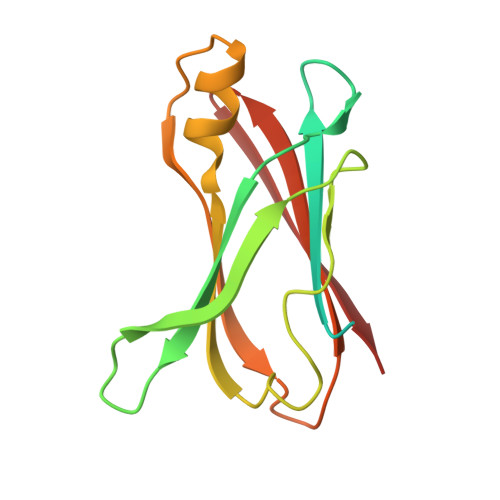A low amyloidogenic E61K transthyretin mutation may cause familial amyloid polyneuropathy.
Murakami, T., Yokoyama, T., Mizuguchi, M., Tone, S., Takaku, S., Sango, K., Nishimura, H., Watabe, K., Sunada, Y.(2021) J Neurochem 156: 957-966
- PubMed: 32852783
- DOI: https://doi.org/10.1111/jnc.15162
- Primary Citation of Related Structures:
6KGB - PubMed Abstract:
Patients with transthyretin (TTR)-type familial amyloid polyneuropathy (FAP) typically exhibit sensory dominant polyneuropathy and autonomic neuropathy. However, the molecular pathogenesis of the neuropathy remains unclear. In this study, we characterize the features of FAP TTR the substitution of lysine for glutamic acid at position 61 (E61K). This FAP was late-onset, with sensory dominant polyneuropathy, autonomic neuropathy, and cardiac amyloidosis. Interestingly, no amyloid deposits were found in the endoneurium of the four nerve specimens examined. Therefore, we examined the amyloidogenic properties of E61K TTR in vitro. Recombinant wild-type TTR, the substitution of methionine for valine at position 30 (V30M) TTR, and E61K TTR proteins were incubated at 37°C for 72 hr, and amyloid fibril formation was assessed using the thioflavin-T binding assay. Amyloid fibril formation by E61K TTR was less than that by V30M TTR, and similar to that by wild-type TTR. E61K TTR did not have an inhibitory effect on neurite outgrowth from adult rat dorsal root ganglion (DRG) neurons, but V30M TTR did. Furthermore, we studied the sural nerve of our patient by terminal deoxynucleotidyl transferase dUTP nick end labeling and electron microscopy. A number of apoptotic cells were observed in the endoneurium of the nerve by transferase dUTP nick end labeling. Chromatin condensation was confirmed in the nucleus of non-myelinating Schwann cells by electron microscopy. These findings suggest that E61K TTR is low amyloidogenic, in vitro and in vivo. However, TTR aggregates and amyloid fibrils in the DRG may cause sensory impairments in FAP because the DRG has no blood-nerve barrier. Moreover, Schwann cell apoptosis may contribute to the neurodegeneration.
- Department of Neurology, Kawasaki Medical School, Kurashiki, Japan.
Organizational Affiliation:

















